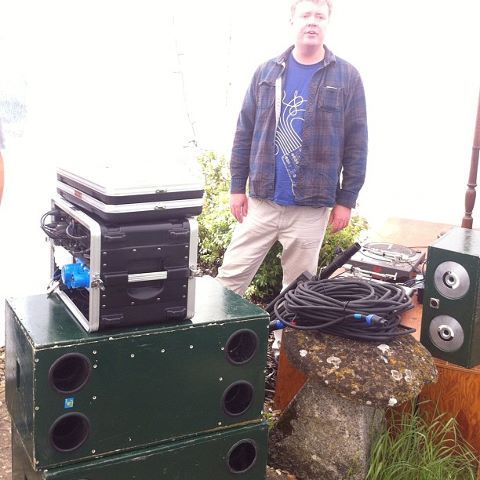- Posts: 170
- Thank you received: 0
FSP-MAGICBOX
- jake_fielder
-

- Offline
- Elite Member
-

Please Log in or Create an account to join the conversation.
- deadbeat
-
 Topic Author
Topic Author
- Offline
- Platinum Member
-

simon, the secret reason for me borrowing your drawings was for me to view their folding, they're similar to a Martin 215 Mk III as you have been told, but have a difference which allows me to save a bit of space, I think. Thanks!
Hmm....
If worst comes to worst we could buy empty chassis and make our own servo loudspeakers! or skint diy recones for custom specs on an existing chassis. I have a few ideas on voice coil winding, think XBL2 technology (double gap, single coil) inverted (split coil, single gap) for similar results. Actually, this one has me thinking...
[img]smileys/smiley36.gif[/img] I'm dreaming alright.
[img]smileys/smiley36.gif[/img]
Edited by: Deadbeat
Beranek\'s law
\'bits of ply round a driver\'
Please Log in or Create an account to join the conversation.
- steve_b
-

- Offline
- Junior Member
-

- Posts: 30
- Thank you received: 0
Nexo uses what they call a Hyperbolic Reflective Wavesource which consists of an acoustical reflector (i.e. mathematically calculated hyperboloid acoustic mirror, derived from rigorous geometrical transformations) this creates path lengths from the virtual and real sources,
to the horn mouths that are identical at the coupling points. Where the two wavefronts touch they will therefore be in phase because the pressure wave takes the same amount of time to travel an identical path length to the coupling point, regardless of where its real source is located in relation to that coupling point .
With some rigorous head scratching, trying to remember my A level maths I believe that the equation for a hyperbola is:
x^2 / a^2 - y^2 / b^2 = 1
Obviously deriving a curved reflector from that equation makes all the difference.
For my version, I shall use the more impressive looking equation of an ellipse:
(x - h)^2 / a^2 + (y - k)^2 / b^2 = 1
The fact is that any surface will act as a reflector. Changing the rate of curvature just changes the focal length Saying that one particular curve is optimum is a bit like saying that there is an ideal pair of glasses that will work for everyone with impaired eye sight. It is still a folded horn and having a curved back section won't eliminate the problems associated with folded horns.
Also the idea that if the sound sources all emanate from the same virtual acoustic centre all will be well is wrong. If you had a row of say four of these horns and stood directly in front of one then if you are in the coverage area of the other horns the path length will be different. The problem is that the path difference after the sound comes out of the horn is the problem.
What has all this got to do with bass cabinets. Simple, stop worrying about the design and concentrate on the marketing.
Meanwhile, back with the ported horn.....
Consider collapsing the mouth of the horn down so that it is a simple tube. Drilling a hole in the side of the tube and connecting a chamber to it with a short pipe will create an acoustic notch filter. Moving away from the resonant frequency the attenuation reduces to zero. As I said before, if the port is to increase efficiency below the operating range of the horn, it, the horn, won't increase the gain of the sound radiating from the port. It will to some extent alter the tuning of the port so conventional calculations used for tuning may be wrong.
If you have not seen it already, there is some interesting reading on horns at Martin King's web site.
<a href=" www.quarter-wave.com/Horns/Horn_Theory.html " target="_blank"> www.quarter-wave.com/Horns/Horn_Theory.html </A>
Please Log in or Create an account to join the conversation.
- deadbeat
-
 Topic Author
Topic Author
- Offline
- Platinum Member
-

I now visualise this as a cutaway Newtonian telescope- I think that's sort of right...
If it is, I completely agree about that statement. Thanks for the explanation.
Thanks for the link to Martin's website, I've read his stuff, nevertheless others should too.
Beranek\'s law
\'bits of ply round a driver\'
Please Log in or Create an account to join the conversation.
- deadbeat
-
 Topic Author
Topic Author
- Offline
- Platinum Member
-

jake, how's it going?
My 215 is taking shape slowly but surely. I'm not sure about the form factor though, I have two sketches - one is dimensioned within the constraints, but the other is like a Martin cab - long and flat.
Beranek\'s law
\'bits of ply round a driver\'
Please Log in or Create an account to join the conversation.
- deadbeat
-
 Topic Author
Topic Author
- Offline
- Platinum Member
-

i've got an idea so crazy, it might just be worthwhile.
When these bins are done (or during this), I am thinking of doing a highly modular midtop that would get down to here. It would be done like this:
www.delicate.com/f2system.htm
Yes, you read that, it's the Martin F2 system.
The bass bins would replace the F2B, and the mid tops would be highly configurable.
Still a pipedream though.
come on simon, i know you have some interesting dreams.
Beranek\'s law
\'bits of ply round a driver\'
Please Log in or Create an account to join the conversation.
- jsg
-

- Offline
- Elite Member
-

- Posts: 236
- Thank you received: 0
Steve_B wrote: Meanwhile, back with the ported horn.....
Consider collapsing the mouth of the horn down so that it is a simple tube. Drilling a hole in the side of the tube and connecting a chamber to it with a short pipe will create an acoustic notch filter. Moving away from the resonant frequency the attenuation reduces to zero. As I said before, if the port is to increase efficiency below the operating range of the horn, it, the horn, won't increase the gain of the sound radiating from the port. It will to some extent alter the tuning of the port so conventional calculations used for tuning may be wrong.
You're right that the throat-ports would tend to attenuate radiation travelling from the front of the driver cone through the horn near the resonant frequency of the rear chamber. But I don't care about that, because at those frequencies the resonance is loading the driver so it is hardly moving anyway.
What I care about is the transfer function from the rear of the driver cone, through the rear chamber and throat port and then through the horn (which would probably be acting as a half-open pipe at these frequencies).
Say we're an octave below the quarter-wave frequency and/or flare rate limit. The horn duct is still givinga littlegain because the gain decays gradually as you move away from resonance. That's gain that can be added on to the output of the rear resonant chamber.
Edit: just been looking at Martin's papers. In Horn_Pysics.pdf figure 5.4, the volume velocity ratio graph clearly shows some remaining gain below 100Hz (which is the horn's nominal cutoff frequency). It may not be much, but at low frequencies every little bit of gain helps, and it therefore makes sense to exploit this one or two dB of gain rather than simply leave the horn doing nothing at these frequencies.
Edited by: jsg
Ars est celare artem
Please Log in or Create an account to join the conversation.
- deadbeat
-
 Topic Author
Topic Author
- Offline
- Platinum Member
-

I'd just like to say that I'm not dead yet, am still working at my own little box!
Might take a bit of time, this is the grunt stage of development.
Omar
</strike>Screw that, I'm on more exciting pastures. More later.
Edited by: Deadbeat
Beranek\'s law
\'bits of ply round a driver\'
Please Log in or Create an account to join the conversation.
- rich_gale
-

- Offline
- New Member
-

- Posts: 18
- Thank you received: 0
i suppose the design could be labeled as a horn assisted passive radiator cabinet.
Please Log in or Create an account to join the conversation.
- jake_fielder
-

- Offline
- Elite Member
-

- Posts: 170
- Thank you received: 0
That sounds like a very interesting idea, although i have never delt with passive radiators, I dont know anything about them... But... do they move in and out far enough for this use? and wouldn't the efficiency of the horn be lost if there was a passive radiator at the end?
Please Log in or Create an account to join the conversation.
